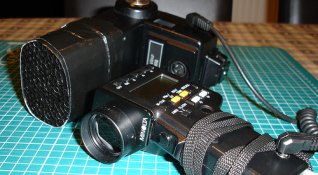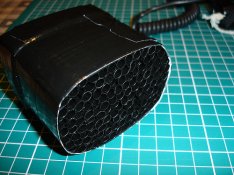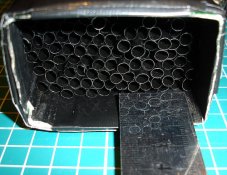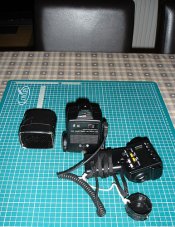I cobbled together this grid modifier, and it seems to be adequate; considering what it is.
I haven't shot any 4x5 FP4+ sheets with it yet. I decided to try to find it's working parameters first before using any film.
According to 'what I have been able to find online', the straws' 2'' length and 3/8'' diameter should return a 25'' diameter hot-spot with a 50'' diameter circle to falloff - although I cannot say for certain at what distance this relates to - I will assume 10 foot.
** My question is - ...If there is any exposure difference to be expected when metering a bare flash; as compared to metering the centre throw from the same flash; with the hot-spot grid attached ? **
Intuitively, I would say no, the intensity of light at the centre of the hot-spot should be the same as the centre of the bare flash's throw. However, when I set up and tested this; as shown in the pics attached, using the chair back as a target spot (2 foot distance); I found I was getting a one to two stop difference in the readings.
I am assuming that the rough-and-ready dimensionalities of my cobbled together creation have resulted in a hot-spot that is being cast slightly off centre, and that although being careful not to, I am metering a section of the inner falloff circle. Also, there is a 2cm gap at the rear of the modifier for attachment to the flash front, and only 1cm of that is holding the grid in place; meaning that there could be light being lost in the 1cm gap between the flash element and the back of the straw 'block'...but a one to two stop difference ??
I realise that in practical use this will probably NOT make THAT much of a difference to any shots; but the journey has made me somewhat curious as to the science behind the mechanisms at play. I have no previous experience of grids or modifiers of any sort, so I don't know how 'properly made' modifiers would/should perform in regard to light loss and exposure settings.
A seemingly long-winded and involved scenario, so I've included a few pics to make myself more easily understood.
JP
I haven't shot any 4x5 FP4+ sheets with it yet. I decided to try to find it's working parameters first before using any film.
According to 'what I have been able to find online', the straws' 2'' length and 3/8'' diameter should return a 25'' diameter hot-spot with a 50'' diameter circle to falloff - although I cannot say for certain at what distance this relates to - I will assume 10 foot.
** My question is - ...If there is any exposure difference to be expected when metering a bare flash; as compared to metering the centre throw from the same flash; with the hot-spot grid attached ? **
Intuitively, I would say no, the intensity of light at the centre of the hot-spot should be the same as the centre of the bare flash's throw. However, when I set up and tested this; as shown in the pics attached, using the chair back as a target spot (2 foot distance); I found I was getting a one to two stop difference in the readings.
I am assuming that the rough-and-ready dimensionalities of my cobbled together creation have resulted in a hot-spot that is being cast slightly off centre, and that although being careful not to, I am metering a section of the inner falloff circle. Also, there is a 2cm gap at the rear of the modifier for attachment to the flash front, and only 1cm of that is holding the grid in place; meaning that there could be light being lost in the 1cm gap between the flash element and the back of the straw 'block'...but a one to two stop difference ??
I realise that in practical use this will probably NOT make THAT much of a difference to any shots; but the journey has made me somewhat curious as to the science behind the mechanisms at play. I have no previous experience of grids or modifiers of any sort, so I don't know how 'properly made' modifiers would/should perform in regard to light loss and exposure settings.
A seemingly long-winded and involved scenario, so I've included a few pics to make myself more easily understood.
JP









